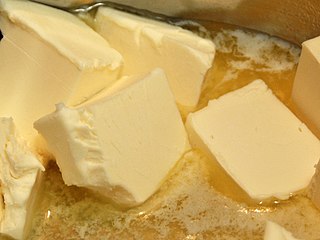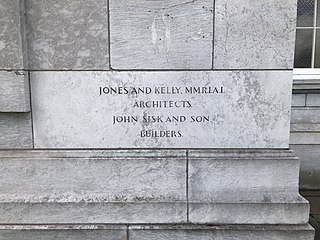
Butter is a dairy product made from the fat and protein components of churned cream. It is a semi-solid emulsion at room temperature, consisting of approximately 80% butterfat. It is used at room temperature as a spread, melted as a condiment, and used as a fat in baking, sauce-making, pan frying, and other cooking procedures.
Glanbia plc is an Irish global nutrition group with operations in 32 countries. It has leading market positions in sports nutrition, cheese, dairy ingredients, speciality non-dairy ingredients and vitamin and mineral premixes. Glanbia products are sold or distributed in over 130 countries. While Europe and the USA represent the biggest markets, the Group are continuing to expand into the Middle East, Africa, Asia Pacific and Latin America. Glanbia's primary listing is on Euronext Dublin. The Group has four segments; Glanbia Nutritionals, Performance Nutrition, Glanbia Ireland and Joint Ventures & Associates, with a combined workforce of over 7,000 employees in 32 countries.

Euronext Dublin is Ireland's main stock exchange, and has been in existence since 1793.
In the Republic of Ireland, the retail sector provides one of the largest sources of employment in the economy, representing over 12% of the workforce. As of 2017, approximately 40,000 wholesale and retail businesses employed almost 280,000 people in Ireland, with the Department of Enterprise, Trade and Employment reporting that 90% of these businesses were Irish-owned.

Cork is the second largest city in the Republic of Ireland, third largest on the island of Ireland, and largest in the province of Munster. At the 2022 census, it had a population of 222,526.
Müller Milk & Ingredients, formerly Robert Wiseman Dairies and later Müller Wiseman Dairies, is the largest milk supplier and distributor in Great Britain. It is part of the Müller UK & Ireland Group, owned by the German Müller family.

Shandon is a district on the north-side of Cork city. Shandon lies north of the River Lee and North Gate Bridge, the northernmost point of the medieval city. Several landmarks of Cork's north-side are located in the area, including the bell tower of the Church of St Anne, the Cathedral of St Mary and St Anne, Saint Mary’s Dominican Church & Priory, and Firkin Crane Arts Centre.

Blackrock is a suburb, with a village core, in the southeast of Cork City, Ireland. Originally a small fishing village about five kilometres from Cork City, the growth of the city over time has meant that the village has become incorporated into the city. It is home to Blackrock GAA club, Blackrock Castle, a weekly farmers market, and as of 2015 has seen some investment in regeneration projects for the traditional village centre. Blackrock is within the Cork South-Central Dáil constituency.

The Church of St Anne is a Church of Ireland church located in the Shandon district of Cork city in Ireland. Built between 1722 and 1726, it is situated on a hill overlooking the River Lee. The church tower is a noted landmark and symbol of the city, and the church bells were popularised in a 19th century song.

Elizabeth Fort is a 17th-century star fort off Barrack Street in Cork, Ireland. Originally built as a defensive fortification on high-ground outside the city walls, the city eventually grew around the fort, and it took on various other roles – including use as a military barracks, prison, and police station. Since 2014, the fort has seen some development as a tourism heritage site, reportedly attracting 36,000 visitors during 2015. The walls of the fort have been accessible to the public on a regular basis since September 2014.
Pork in Ireland has been a key part of the Irish diet since prehistory. Ireland's flora and fauna overwhelmingly arrived via a Neolithic land bridge from Great Britain prior to its submerging around 12,000 BP. When the very first hunter-gatherers arrived around 2,000 years later, the local ecosystem largely resembled that of modern Ireland.

Ornua, from the Irish "Ór Nua" meaning "new gold", is an Irish agricultural cooperative, which markets and sells dairy products on behalf of its members: Irish dairy processors and Irish dairy farmers. The co-operative is Ireland’s largest exporter of Irish dairy products and owns the Kerrygold butter and cheese brand as well as Kerrygold Irish Cream Liqueur. In addition to the Kerrygold brand, its brand portfolio includes Pilgrims Choice, Dubliner, Shannongold, and BEO milk powder.

The Milk Market is a food market located on Mungret Street, Limerick, Ireland. Despite the name, the market has diversified over the years from its initial purpose and now sells a wide variety of foodstuffs, much of which is produced locally. The market is one of the oldest in Ireland. The flagship market day is the Saturday food market, however, markets are also held on Fridays and Sundays.

The Irish Agricultural Museum is a museum dedicated to the history of Irish rural life. Housed in the farm and stable courtyard buildings of Johnstown Castle, County Wexford, the collections represent all elements of rural life, including transport, crafts, farming activities and dwelling.

Clare Museum is a museum which documents the history of County Clare. The museum is housed in the former Sisters of Mercy Convent in the centre of Ennis.

The City Hall, Cork is a civic building in Cork, Ireland which houses the administrative headquarters of Cork City Council.

Shandon Street, formerly known as Mallow Lane, is a street in the Shandon area of Cork City, Ireland and is a retail area on the North-Side of Cork city.

Shandon Castle, originally known as Lord Barry's Castle, was an early medieval castle in the Shandon area of Cork city in Ireland. It was built in the late 12th century by Philip de Barry, close to an earlier ringfort. Located outside the city's gates and defensive walls, the castle was a seat of the Cambro-Norman de Barry family for several centuries.

The Firkin Crane is a non-profit arts organisation based in the protected building of the same name in the Shandon area of Cork City in Ireland. It is a theatre and dance centre and is a permanent base for Cork City Ballet and Crux Dance Theatre.


















